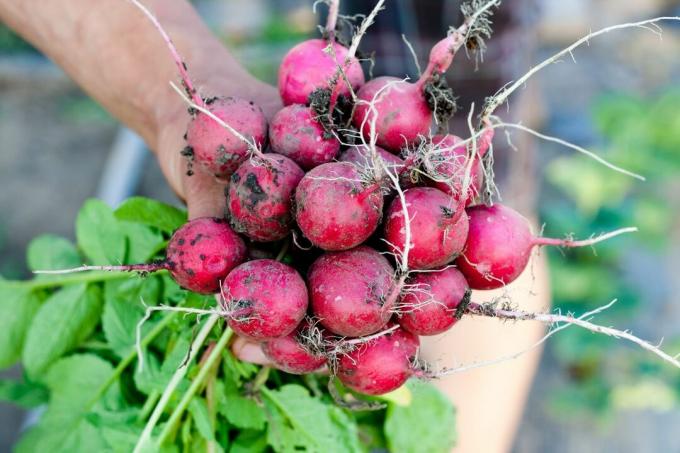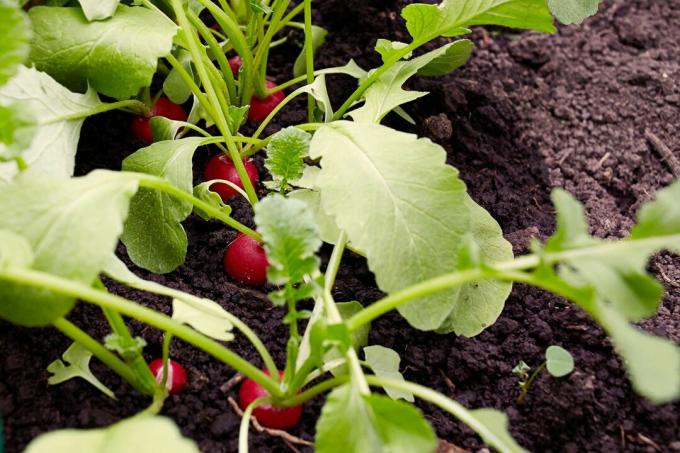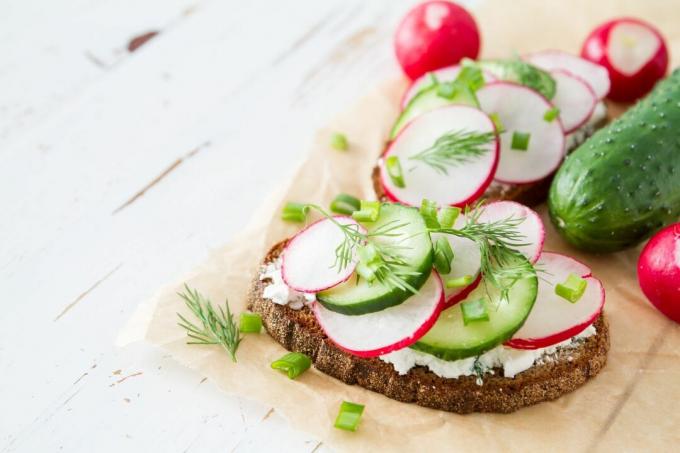Radishes are high on the menu in summer. The radishes also grow well in the garden. We show what radish leaves and flowers look like and how to properly care for the plants.

The radish (Raphanus sativus var. sativus) is high on the list of the most popular summer vegetables. From a botanical point of view, the radish, also called radish, belongs to the cruciferous family (Brassicaceae). This also includes types of cabbage such as broccoli (Brassica oleracea var. italica), cauliflower (Brassica oleracea var. botrytis) and Kohlrabi (Brassica oleracea var. gongylodes).
contents
-
Radish profile: origin, growth phases and properties
- Radish leaves
- Radish blossom
- Harvest radish seeds
-
Radish care
- Radish seedling: do you have to prick out radishes?
- Pour the radishes
- Fertilize radishes
-
Harvest radishes
- When can you harvest radishes?
- How do you harvest radishes?
- Store and preserve radishes
- Ingredients and uses of radishes
- Radish pests and diseases
Radish profile: origin, growth phases and properties
The tasty, slightly spicy tuber is very well known in this country, although it does not have a particularly long tradition in our country. The radish originally comes from Asia and was only found in the 16th century. Century made its way to Europe. Due to their comparatively short cultivation time (4 to 8 weeks depending on the variety and time of year), the crunchy sprout tubers are often used in the garden as pre- or post-cultivation or Grown between other vegetable crops and also in pots on the balcony, they can be cultivated successfully.
Depending on the variety, the radishes take on a spherical or oblong-conical shape. In addition, the varieties differ in their color, their taste and when they are best grown. In our special article about Radish varieties you can find out about the variety of Raphanus sativus var. sativus inform and find the right varieties for you.

If the radish seeds are sown, they germinate within a few days to a week, depending on the temperature and weather, and the two heart-shaped cotyledons appear. After the development of the root, shoot axis and cotyledons, the secondary growth in thickness of the shoot axis follows. It stores reserves and develops into the crunchy, healthy tuber that we like to eat.
After completion of the vegetative growth phase, the radish plant goes into the generative growth phase. In this phase the seeds for reproduction are formed. The marrow cells of the sprout tubers lignify for more stability. The radishes become hard and inedible. If your goal is not to obtain seeds, you should therefore keep a close eye on the radishes and harvest them in good time, even before they start to shoot up.

Radish leaves
After the two cotyledons, several dark green, hairy leaves with irregularly serrated edges on thin petioles develop above the stem axis. The radish leaves are edible and very healthy due to their high mustard oil content. Instead of throwing away the leaves of the radishes, they can be processed into a spicy pesto or a tasty soup, for example.
Radish blossom
If the temperatures and drought are too high during the growth phase or if the ripe sprouts are not harvested in time, the radishes shoot into seed. This means that countless white to pink cruciferous flowers form on a radish. From this point onwards, the radishes are inedible for us humans, but insects such as bees and butterflies find plenty of food in the flowers. After flowering, 3 to 4 cm long, green pods are formed. The radish pods are edible when fresh.

If you have a little more patience, you can wait until the seeds are ripe. When you open the dried pods, the small seeds emerge, which can then be sown again. When the gardening year is over, you can sow the seeds indoors on the windowsill and harvest mildly hot radish sprouts after a few days.
Harvest radish seeds
Radishes can only be propagated through their seeds. However, they are self-sterile and to prevent inbreeding symptoms such as poor growth, several plants should bloom next to each other. To obtain radish seeds, it is advisable to have at least 15 to 20 healthy plants bloom. Insects visit the numerous flowers of the radishes and pollinate them. Incidentally, radishes and radishes can crossbreed if they are close together because they belong to the same species. If the radishes were sown in March, ripe seeds can be harvested as early as August. The seed heads reach 150 to 200 cm in height, so a support structure can be useful.
The seed pods should be collected from late summer when the plant is still vital but the seeds in the pods have already turned brown. Let the pods ripen and dry in the house for a few weeks before they are cracked and the reddish-brown radish seeds are extracted. The seeds are also dried well again and then stored dry, protected from light and in a cool place. Radish seeds have a long shelf life and can therefore still germinate after more than six years.
Harvest radish seeds:
- Let at least 15-20 radish plants bloom for good pollination.
- Support seed heads and tie up if necessary.
- Harvest whole plants or individual seed pods when the seeds in them have turned brown.
- Let dry well in the house for several weeks.
- Crack the seed pods and get radish seeds.
- Dry the seeds afterwards, then store them in a cool, dark and dry place.
Radishes can be grown both in the vegetable patch in the garden and in a pot on the balcony or terrace. How exactly you go about sowing radish seeds is covered in our special article Planting radishes described.
Tip: In our Plantura vegetable growing kit everything you need for successful vegetable sowing is available - including a mini greenhouse, pots, substrate and seeds for five different types of vegetables.
Radish care
Radishes are very easy to care for and require no special care in addition to a regular water supply. Occasionally, weeds can be removed or the soil loosened to improve the oxygen supply. But even without these measures, the radishes thrive well.
Tip: Note that radishes are not rotated between other cruciferous vegetables such as cabbage, or radish horseradish (Armoracia rusticana) should stand. The culture itself should not be grown several times in a row on the same area. Otherwise illnesses often occur.
Radish seedling: do you have to prick out radishes?
Radish seeds can either be sown individually, with sufficient spacing, or sprinkled directly from the bag onto the substrate. The second method requires isolation, called pricking out, after germination. The radish seedlings are carefully removed from the substrate in the cultivation container, separated from one another and replanted at a distance in a sufficiently large pot or bed. Now the radish plants can develop and continue to grow without competition.

Pour the radishes
Radishes must be supplied with sufficient water, especially at the beginning, so that the seeds germinate successfully and the seedlings can develop into large, round tubers after sowing. Use a watering attachment to distribute the water over the radishes.
Fertilize radishes
Before the radishes were sown, the soil was filled with a primarily organic fertilizer like ours Plantura organic universal fertilizer or enriched with a little compost, this is completely sufficient for radishes, which are among the low-eaters. Further fertilization measures during the vegetation phase are not necessary.
Harvest radishes
Radishes are ripe for harvest when the round, red bulbs are slightly smaller than a table tennis ball. If in doubt, it is better to harvest smaller radishes, they are definitely still tender and tasty. Tubers that are too large quickly become woody and inedible.

When can you harvest radishes?
Depending on the season, radishes need around four to eight weeks to be harvested. If you have sown radishes in rows, you should start harvesting early when the tubers are still small. Otherwise it can quickly happen that you can no longer deal with the harvest or comes after consumption. Radishes shouldn't grow too long. If the radish is very large, it can become lignified and the outside of the pulp becomes fibrous.
How do you harvest radishes?
When harvesting, you grasp the radish leaves just above the tuber and pull the radishes out of the ground. You should be careful not to damage the tubers. This significantly reduces the shelf life.
Store and preserve radishes
Once harvested, radishes can be stored in the refrigerator for a few days. To do this, remove the leaves, as this would otherwise drain the tubers unnecessarily and wrap the radishes in a damp kitchen towel.
Fresh radishes can also be frozen after washing and removing the leaves, but they can be lost the sprout tubers usually get their crunchy consistency and have a less intense consistency after thawing Taste. An alternative variant for long-term preservation is to soak radish slices in vinegar.

Ingredients and uses of radishes
With less than 15 kcal per 100 g, the tuber is very low in calories and also ideal for a diet. The fiber also ensures a feeling of satiety. Radishes mainly contain vitamin C, small amounts of vitamin B / B9 and a balanced amount of minerals. These include potassium, magnesium, calcium and iron.
In addition to vitamins and minerals, the radishes contain mustard oils (mustard oil glycosides), which are also responsible for the spicy note. These secondary plant substances are said to have an antibacterial, antifungal (anti-fungal) and digestive effect. The crunchy tuber is mainly consumed raw. But it also tastes delicious in soups, in the oven or in the pan. However, the most common use of radishes is still as a quick snack between meals, as an ingredient in a salad or as an accompaniment to a lunch plate. Especially in Bavaria, the spicy dumplings should not be missing on a snack plate in the beer garden.
Radish pests and diseases
Radish plants can be attacked by the classic cabbage diseases and pests. These include the cabbage fly, earth fleas and the cabbage white butterfly. The following two fungal diseases can also cause problems: the dreaded carbonic hernia, the exuberant Thickening of the roots results in the blackness of the radish, in which the radishes turn black from the outside discolor. In both cases, the plants should be destroyed in the residual waste for safety. No plants from the cruciferous family should be grown in the same location for at least four to five years.
If you feel like growing your own radishes in the garden or on the balcony, you can take a look at our special article on the subject Planting radishes Continue reading. There you will find information on the exact procedure.

